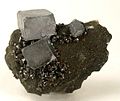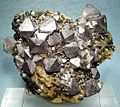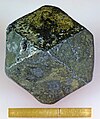Galena
| Galena | |
|---|---|
| Galena with siderite (brownish) and quartz (colorless) from Neudorf (Harzgerode) , Saxony-Anhalt, Germany (size: 13.2 × 9.0 × 5.4 cm) | |
| General and classification | |
| other names |
|
| chemical formula | PbS |
|
Mineral class (and possibly department) |
Sulfides and sulfosalts |
|
System no. to Strunz and to Dana |
2.CD.10 ( 8th edition : II / C.15) 08/02/01/01 |
| Crystallographic Data | |
| Crystal system | cubic |
| Crystal class ; symbol | cubic hexakisoctahedral; 4 / m 3 2 / m |
| Space group | Fm 3 m (No. 225) |
| Lattice parameters | a = 5.92 to 5.93 Å |
| Formula units | Z = 4 |
| Frequent crystal faces | {100}, {111}, {110}, {221} |
| Twinning | {111} |
| Physical Properties | |
| Mohs hardness | 2.5 to 3 (VHN 100 = 79 to 104) |
| Density (g / cm 3 ) | measured: 7.58; calculated: 7.57 (as ore 7.2 to 7.6 g / cm³ depending on the composition) |
| Cleavage | completely after {100} |
| Break ; Tenacity | slightly mussel-like |
| colour | lead gray; pure white on polished surfaces |
| Line color | lead gray |
| transparency | opaque |
| shine | Metallic luster |
| Other properties | |
| Chemical behavior | dissolves in nitric acid (HNO 3 ) |
Galena , also known under its mining name lead gloss , is a widespread mineral from the mineral class of " sulfides and sulfosalts ". It crystallizes in the cubic crystal system with the composition PbS, so chemically speaking it is lead (II) sulfide .
Galena often develops crystals of perfect cube shape, but also octahedral , more rarely tabular or skeletal crystals and massive aggregates of lead-gray color and line color . Galena crystals show a pronounced metallic luster , especially on freshly broken surfaces . Mineral aggregates , on the other hand, are usually matt. Occasionally there are also galena with brightly colored tarnishing.
Galena is by far the most important ore for the extraction of lead and because of the often contained admixture of silver also an important silver ore.
Etymology and history
The Latin name “Galena” has already been handed down by the Roman scholar Pliny the Elder (approx. 23–79 AD). The use of the mining word “shine” for lead ore has been documented since the 16th century, but later became the general collective name for all metallically shiny, sulphidic ores ( copper sheen , silver sheen ). Abraham Gottlob Werner (1749–1817) coined the term “lead gloss” to distinguish it, and from around 1850 onwards the term “galena” was also used.
Galena is one of the oldest ore minerals in cultural history for the extraction of lead. The oldest known lead finds so far come from the Stone Age settlement of Çatalhöyük (Çatal Hüyük) , around the time between 5,500 and 4,800 BC. A lead ring found in Yarim Tepe in present-day Iraq is estimated to be of a similar age . The most famous peoples of antiquity who produced or used lead included the Babylonians , Egyptians and Romans (see also lead # history ) .
Lead was already known in ancient Greece . The Pb-Ag deposits of Laurion , however, were mainly used to extract silver , while the by-product lead was mostly discarded.
classification
In the meanwhile outdated, but still in use 8th edition of the mineral classification according to Strunz , the galena belonged to the mineral class of " sulfides and sulfosalts " and there to the department of "sulfides with the molar ratio of metal: sulfur , selenium , tellurium ≈ 1: 1", where he as the namesake the "Galenit series" with the system no. II / C.15 and the other members Alabandin , Altait , Clausthalit , Crerarit , Keilit , Niningerit and Oldhamit .
The 9th edition of Strunz's mineral systematics , which has been in effect since 2001 and is used by the International Mineralogical Association (IMA), also classifies galena in the category of "Metal sulfides (with the molar ratio) M: S = 1: 1 (and similar)". However, this is further subdivided according to the dominant metal ions in the compound, so that the mineral can be found according to its composition in the sub-section "with tin (Sn), lead (Pb), mercury (Hg) etc.", where it is also named the "galena group" with the system no. 2.CD.10 and the other members Alabandin, Altait, Clausthalit, Keilit, Niningerit and Oldhamit.
The systematics of minerals according to Dana , which is mainly used in the English-speaking world , assigns galena to the class of "sulfides and sulfosalts" and there in the department of "sulfide minerals". Here he is also the namesake of the "Galenit Group (isometric: Fm 3 m )" with the system no. 02.08.01 and the other members Clausthalit, Altait, Alabandin, Oldhamit, Niningerit, Borovskit , Crerarit and Keilit within the subdivision of " Sulphides - including selenides and tellurides - with the composition A m B n X p , with (m + n) : p = 1: 1 “.
Crystal structure
Galena crystallizes isotypically with halite (NaCl) in the cubic crystal system in the space group Fm 3 m (space group no. 225) with the lattice parameter a = 5.92 Å and four formula units per unit cell .
The crystal structure of galena (PbS) corresponds to the sodium chloride structure and therefore consists of two face -centered cubic lattices of lead and sulfur atoms shifted by half a unit cell . In other words, each lead atom is octahedral surrounded ( coordinated ) by six sulfur atoms and, conversely, each sulfur atom is surrounded by six lead atoms.
Other minerals of this structure type are altaite (lead telluride , PbTe), clausthalite ( lead selenide , PbSe) and alabandin ( manganese sulfide , α-MnS).
properties
morphology
The most common crystal shape observed in galena is the cube {100}, mostly in combination with the octahedron {111}. If cube and octahedron surfaces are in equilibrium, this combination is also known as a cuboctahedron . The rhombic dodecahedron {110}, the trisoctahedron surfaces {221} and {331}, as well as icositetrahedron surfaces {211} and others can be found with mostly small surfaces . However, purely octahedral crystals are very rare.
The crystals are mostly isometric, and more rarely they have grown like a skeleton. Grape-shaped, stalactitic or leafy, queasy aggregates are rare and cell-eaten crystals are often fakes.
Often there are crystal twins with the octahedral surface (111) as the twin plane. These twins can be distorted plate-like parallel to the twin plane.
Also epitaxial adhesions with crystals of the same species (Homoepitaxy) or other minerals (hetero-epitaxy), such as pyrite are known.
Almost perfect galena cuboctahedron (combination cube-octahedron), line of sight perpendicular to a corner (for comparison: cuboctahedron # orthogonal projection )
Physical Properties

Galena is usually light to dark, lead-gray in color and also lead-gray color . On the other hand, on polished surfaces it shows a pure white reflection color, which is used as a color standard in ore microscopy .
Typical properties of galena include its metallic luster, which is characteristic of many sulfide minerals, and its low hardness, as well as its very perfect cleavage after the cube surface {100} (rarely also after the octahedron surface {111}) and its high density, which is the highest compared to the other lead ores of 7.58 g / cm³. Only the very rare lead amalgam has a higher density of 11.96 g / cm³.
With a Mohs hardness of 2.5 to 3, galena is still one of the soft minerals, which can no longer be scratched with a fingernail like the softer mineral gypsum (hardness 2), but easier than calcite (hardness 3) with a copper coin.
The melting point of galena ( lead (II) sulfide ) is 1114 ° C.
Chemical properties
Galena melts with a crackling sound in front of the soldering tube , forms a greenish-yellow coating on the charcoal and leaves a grain of lead after the sulfur has evaporated.
In nitric acid (HNO 3 ) decomposes galena, said sulfur is deposited and a white precipitate of lead sulfate (PbSO 4 forms).
Modifications and varieties

In pure form, galena has a mass fraction of 86.6% lead and 13.4% sulfur, which is only achieved with synthetically produced lead sulfide . Naturally formed galena always contains foreign admixtures of other elements, which either replace small amounts of lead or sulfur . Of these simple, chemical varieties , especially those with additions of silver , gold , bismuth and / or selenium are known. In most cases, such varieties are not given a proper name or are only provided with the addition of the element they contain (example "silver-containing galena" or "silver galena"). “Uranium galena” (“U-galena” for short), on the other hand, contains the lead isotope 206 Pb, which is formed when the uranium isotope 238 U decays . Another variety in which part of the sulfur has been replaced by selenium is also known as "selenium lead ore". Other additions, usually only contained in traces, can include copper (Cu), iron (Fe), antimony (Sb), zinc (Zn) and arsenic (As) as well as cadmium (Cd), tin (Sn) and carbon (C) and are usually due to the finest adhesions or segregation of other mineral phases.
"Steinmannite" was initially thought to be an independent mineral and was described by Franz Xaver Zippe in 1833 as a new mineral from the lead mines near Příbram (Czech Republic), which consisted of lead-gray, grape-like to kidney-shaped aggregates with small, clearly octahedral, superimposed crystals of the same mineral. Zippe was particularly conspicuous in that it was only weakly cleavable in contrast to lead gloss. The mineral also had a lower density (6.833 g / cm³). The other properties (crystal system, color, line color, Mohs hardness), however, were similar to lead gloss. Zippe stated the composition of lead, antimony and sulfur in the form of lead sulfur (galena) and antimony sulfur ( stibnite , antimonite ) in an approximate ratio of 3: 1 and a small amount of silver, but could not carry out a more detailed analysis due to the lack of equipment. He named the new mineral after the professor of chemistry at the Prague Polytechnic Institute Johann Joseph Steinmann (1779–1833).
In the following mineralogical tables, steinmannite is no longer regarded as an independent type of mineral, but as a variety of galena. Thus, among others, Sigmund Caspar Fischer, in his “Handbuch der Mineralogie” from 1840 , lists a so-called stone mannite (also octahedral lead gloss ) from Příbram in Bohemia and Paul Heinrich von Groth in his “Tabular overview of minerals according to their crystallographic chemical relationships ”in his comment on galena (lead luster) states that stone mannite is a galena containing antimony and arsenic. Kenngott (1818–1897), Reuss (1761–1830) and Schwarz, on the other hand, viewed the steinmannite as an impure mixture of galena, zinc sulfur ( sphalerite ) and arsenic sulfur ( realgar ).
“Lead tail” is the term used to describe galena aggregates that have been plastically deformed, rolled out and fine-grained to coarse by tectonic processes . A special lead tail with a high silver content and a correspondingly lighter color was known as "Weißgiltigerz" according to Fischer. According to other sources, the white gold ores (also white gold ore or white gold ) are no longer a common name for gray silver ores, which were created analogously to the red gold ores and, like these, were divided into dark and light white gold ores .
"Bleimulm", also queasy lead gloss or lead blackness , is a scaly variety with little internal cohesion (easily friable), which Fischer viewed as a product of destruction.
"Knottenerz" (also knot ore or lead sander ore ) is an intimate intergrowth of sandstone , galena and other lead ores that was found on the Bleiberg in the Eifel , among other places .
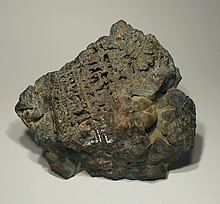
A “knitted screen” (also knitted lead luster ) is a “knitted” looking intergrowth of dendritically formed galena with a shell screen , sphalerite and / or silver luster ( acanthite ).
According to Groth, “Quiroguit” is a mixture of galena, antimonite and pyrite with very distorted crystals, and “Cuproplumbit” (also copper lead luster) is a mixture of PbS (galena) and Cu 2 S ( chalcosine ) with a predominant proportion of galena. He also considers the minerals "fournetite", "huascolith" and "plumbomanganite", which occur in coarse aggregates, to be mixtures of galena with other ores.
Another mixture known as the “ shell diaphragm ” consists of sphalerite and wurtzite as well as admixtures of galena and other lead sulfides.
As " Blaubleierz " (English Plumbeine ) a pseudomorph from galena by Pyromorphit designated. In addition, other pseudomorphoses such as Cerussit are known.
Education and Locations
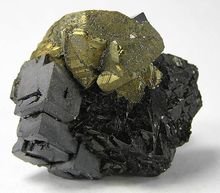
Galena is a so-called "run-through mineral" that forms in intramagmatic to cold-thermal deposits . Galena is also stable under sedimentary and metamorphic formation conditions. The vast majority of deposits are of a hydrothermal nature, where the mineral either crystallizes in dikes of plutonites (more rarely volcanites ) or is formed by displacement of other minerals, including limestone and dolomite .
Galena is often found in paragenesis with sphalerite and chalcopyrite . However, depending on its educational possibilities, it can also be associated with many other minerals such as barite , calcite , dolomite , marcasite , pyrite , siderite , tetrahedron and quartz . By weathering in the oxidation zone of the lead deposits Galenit gradually changes in the minerals Cerussit (cerussite) , Anglesit (Bleivitriol) , Pyromorphit ( green or Braunbleierz ) Mimetesit (Arsenikbleispath) above and other secondary lead minerals.
As a widespread mineral formation, galena has been found in many places around the world, with around 21,000 known sites so far (as of 2013). The seven most important producing nations for lead ore in 2011 included the People's Republic of China (2.36 million tons), Australia (621,000 tons), the USA (342,000 tons), Peru (230,000 tons) and Mexico (223,717 tons), Russia (113,000 tons) and Bolivia (100,051).
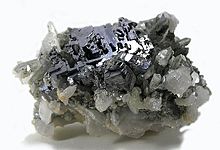
Joplin and Ellington (Sweetwater Mine) in Missouri, Galena in Kansas and Picher in Oklahoma in the USA, where galena crystals several dozen centimeters in diameter emerged, are known for their extraordinary galena finds . Skeletal crystals and twins according to the spinel law with a diameter of up to 20 cm were found in the "Nikolaevskiy Mine" (Nikolai Mine) near Dalnegorsk in Russia. Skeletal galena crystals, which look similar to those of synthetically produced bismuth , are also known from burning coal heaps such as the “Kateřina mine” near Radvanice v Čechách in the Czech Republic.
One of the largest known galena crystals with a cube-shaped habit , an edge length of 25 cm and a weight of 118 kg is kept in the British Museum in London. It was extracted from the "Great Laxey Mine" on the Isle of Man .
Significant discovery areas in Germany are or were, among others, the Freiberg vein district in the Saxon Ore Mountains with an extension of 40 × 50 km, the hydrothermal veins at Clausthal-Zellerfeld , Bad Grund and Sankt Andreasberg in the Upper Harz and Neudorf in the East Harz; the synsedimentary-exhalative-submarine ore deposit in Rammelsberg near Goslar, the Triassic sediments near Mechernich and Maubach in North Rhine-Westphalia, and Wiesloch south of Heidelberg and Walhausen in Saarland.
In Austria, Galenit appeared in the districts of Bad Bleiberg and Friesach - Hüttenberg in Carinthia; in various mines in the industry , cider and Waldviertel of Lower Austria; in many places in the Hohe Tauern and in the Habach Valley in Salzburg; in several places in the Fischbacher Alps , in the Murau district and in the area around Bruck an der Mur in Styria; in the Inn Valley and in the Imst - Nassereith mining area (see also Mining Open-Air Museum Knappenwelt Gurgltal ). In Upper Austria, Galenit can be found in some places in the Gmunden district and the Windischgarsten municipality in the Kirchdorf an der Krems district in Upper Austria, as well as in some places in the Montafon Valley in Vorarlberg.
In Switzerland, the mineral is known so far mainly from the cantons of Bern (Haslital), Graubünden (Albulatal, Val S-charl, Val Poschiavo), Ticino (Malcantone), Uri (Reuss Valley) and Wallis (Binntal, Val d'Anniviers) .
Other locations are in Afghanistan , Algeria , Angola , Antarctica , Argentina , Armenia , Azerbaijan , Belgium , Botswana , Brazil , Bulgaria , Chile , Ecuador , Finland , France , Ghana , Greece , Greenland , India , Indonesia , Iran , Ireland , Italy , Japan , Cambodia , Canada , Kazakhstan , Kyrgyzstan , Colombia , Madagascar , Morocco , Mongolia , Myanmar , Namibia , Netherlands , New Zealand , Norway , Papua New Guinea , the Philippines , Poland , Portugal , Romania , Saudi Arabia , Sweden , Slovakia , Spain , South Africa , Czech Republic , Tunisia , Turkey , Hungary , Venezuela , Vietnam , the United Kingdom (England, Scotland, Wales).
Also in mineral samples from the hydrothermal field of the transatlantic geotraverse ( Trans-Atlantic Geotraverse hydrothermal field , TAG) on the Mid-Atlantic Ridge as well as from the Manus Basin of the Bismarck Sea and from several locations on the East Pacific Ridge (EPR 9-10 ° N, Guaymas Basin, Juan- de Fuca back ), galena could be detected.
use
As a raw material
Galena is the most important lead ore due to its high lead content of up to 87% and its wide distribution . The secondary minerals cerussite, pyromorphite, anglesite and mimetesite that arose from it have a similarly high lead content, but are much less common in contrast to galena. Because of its frequent additions of silver, which can amount to several percent by weight, but on average only between 0.005 and 0.4%, galena is also an important silver ore . After roasting and reducing , the silver contained is separated from the raw lead using the Parkes process (also known as Parkesizing ).
Due to its relatively simple extraction and its low melting point (≈ 327 ° C), lead was used early on for the production of various everyday objects. The lead vases of the Babylonians as well as lead pipes for fresh water and sewage and lead sheets for cladding house roofs and hulls are known by the Romans. The negative consequences, among other things due to the use of lead for wine vessels, which led to the formation of lead sugar and made the wine sweeter, were already known in antiquity and passed down through the Latin term “saturnism” for lead poisoning .
For information on the use of lead in modern times, see lead # Use .
Other uses
As early as the Old Kingdom of Egypt , the silver-gray galena was used in cosmetics alongside the green malachite , primarily to emphasize the eyes. Through heat treatment in the fire, finely crushed galena could also be converted into a reddish pigment ( red lead ) and used as a blush for lips and cheeks. Noble Greek women lightened face and skin with white lead on the first of elemental lead made be had.
Due to its properties as a semiconductor , galena or lead (II) sulfide was used as a rectifier ( demodulator ) in detector receivers in early radio technology . In addition, the mineral was also used to produce corrosion-resistant glazes for various ceramic products and to reduce the spontaneous combustion of the white phosphorus contained in old matches from the 19th century.
Manipulations and imitations

Since galena is not a seldom occurring mineral and beautiful crystal levels can often be found, counterfeits are only found in a few cases. Well-known exceptions are forgeries of partially dissolved crystals, as these are very rare in nature and therefore achieve top prices in the mineral trade. It is difficult to distinguish between naturally partially dissolved crystals and, in case of doubt, can only be made by examining the surfaces with an electron microscope for traces of processing or residues of grinding or polishing agents.
See also
literature
- Hans Jürgen Rösler : Textbook of Mineralogy . 4th revised and expanded edition. German publishing house for basic industry (VEB), Leipzig 1987, ISBN 3-342-00288-3 , p. 304-306 .
- Helmut Schrätze, Karl-Ludwig Weiner: Mineralogy. A textbook on a systematic basis . de Gruyter, Berlin; New York 1981, ISBN 3-11-006823-0 , pp. 199-207 .
- Paul Ramdohr , Hugo Strunz : Klockmann's textbook of mineralogy . 16th edition. Ferdinand Enke Verlag, 1978, ISBN 3-432-82986-8 , pp. 439-442 .
- Martin Okrusch, Siegfried Matthes: Mineralogy: An introduction to special mineralogy, petrology and deposit science . 7th edition. Springer Verlag, Berlin, Heidelberg, New York 2005, ISBN 3-540-23812-3 , pp. 33, 34 .
- Petr Korbel, Milan Novák: Encyclopedia of Minerals . Nebel Verlag GmbH, Eggolsheim 2002, ISBN 3-89555-076-0 , p. 35 .
Web links
- Mineralienatlas: Galenit und Mineralienatlas: Mineralienportrait / Galenit (Wiki)
- Mindat - Galena (English)
- Database-of-Raman-spectroscopy - Galena
Individual evidence
- ↑ a b c d e Webmineral - Galena (English)
- ^ A b c d e Helmut Schrätze , Karl-Ludwig Weiner : Mineralogie. A textbook on a systematic basis . de Gruyter, Berlin; New York 1981, ISBN 3-11-006823-0 , pp. 199 .
- ↑ a b American Mineralogis Crystal Structure Database - Galena (Noda et al. Acta Crystallographica Volume C43, 1987, pp. 1443–1445)
- ↑ a b c d Galena . In: John W. Anthony, Richard A. Bideaux, Kenneth W. Bladh, Monte C. Nichols (Eds.): Handbook of Mineralogy, Mineralogical Society of America . 2001 ( handbookofmineralogy.org [PDF; 58 kB ]).
- ↑ a b Kremer pigments - galena, Galena (PDF 47.2 kB)
- ↑ Hans Lüschen: The names of the stones. The mineral kingdom in the mirror of language . 2nd Edition. Ott Verlag, Thun 1979, ISBN 3-7225-6265-1 , p. 190 .
- ↑ Wolfgang Piersig: Lead - metal of antiquity, the present, with a future, a material for technology, culture, art . GRIN Verlag, Annaberg-Buchholz 2011, ISBN 978-3-656-07283-6 , p. 4 ( excerpt from Google book search).
- ↑ a b c d e Hans Jürgen Rösler : Textbook of Mineralogy . 4th revised and expanded edition. German publishing house for basic industry (VEB), Leipzig 1987, ISBN 3-342-00288-3 , p. 304 .
- ↑ a b Friedrich Klockmann : Klockmanns textbook of mineralogy . Ed .: Paul Ramdohr , Hugo Strunz . 16th edition. Enke, Stuttgart 1978, ISBN 3-432-82986-8 , pp. 440 (first edition: 1891).
- ↑ a b Exploration of the Hollowed Galenas (accessed October 18, 2011)
- ↑ Mindat - epitaxy between galena and pyrite
- ^ Entry on lead (II) sulfide in the GESTIS substance database of the IFA , accessed on April 24, 2010 (JavaScript required)
- ^ A b c d Helmut Schrätze , Karl-Ludwig Weiner : Mineralogie. A textbook on a systematic basis . de Gruyter, Berlin; New York 1981, ISBN 3-11-006823-0 , pp. 200 .
- ↑ Mindat: Argentiferous Galena , Auriferous Galena , Bismuthiferous Galena , Selenian Galena and U-Galena
- ↑ a b c d Sigmund Caspar Fischer : Handbook of Mineralogy . 2nd Edition. Heubner, Vienna 1840, p. 297 ( limited preview in Google Book search).
- ↑ FXM Keep surfing : Above the Steinmannit, a new species of the mineral kingdom , In: proceedings of the Society of the Patriotic Museum in Bohemia , Volume 11 (1833), pp 39-44. ( available online in Google Book Search)
- ↑ a b P. Groth : Tabular overview of the minerals according to their crystallographic-chemical relationships . 4th edition. Vieweg, Braunschweig 1898, p. 26 ( available online at archive.org [accessed September 14, 2013]).
- ^ Carl Friedrich Naumann : Elements of Mineralogy . Ed .: Ferdinand Zirkel . 12th edition. Wilhelm Engelmann, Leipzig 1885, p. 329 ( available online at archive.org [accessed September 14, 2013] first edition: 1846).
- ↑ Hans Lüschen: The names of the stones. The mineral kingdom in the mirror of language . 2nd Edition. Ott Verlag, Thun 1979, ISBN 3-7225-6265-1 , p. 342 .
- ↑ White valid ore . In: Heinrich August Pierer (ed.): Pierer's Universal Lexikon . 4th edition. tape 19 . Publishing bookstore HA Pierer, New York, Altenburg 1865, p. 68 ( copy at zeno.org or the original in the Google book search).
- ^ A b Karl Caesar von Leonhard : Handbuch der Oryktognosie: for academic lectures and for self-study . Mohr and Winter, Heidelberg 1821, p. 230 ( limited preview in Google Book search).
- ↑ Mineralienatlas: Knottenerz
- ↑ Mineralienatlas: knitted bezel
- ↑ Knitted cover at stolberg-abc
- ↑ Mindat - pseudomorphism from galena to cerussite
- ↑ Hans Jürgen Rösler : Textbook of Mineralogy . 4th revised and expanded edition. German publishing house for basic industry (VEB), Leipzig 1987, ISBN 3-342-00288-3 , p. 305 .
- ↑ Mindat - Number of localities for galena
- ↑ British Geological Survey (BGS) - World mineral statistics archive ( PDF (582.8 kB) of the 2011 statistics ; Blei mining nations from p. 42)
- ↑ Petr Korbel, Milan Novák: Mineral Encyclopedia (= Dörfler Natur ). Nebel Verlag, Eggolsheim 2002, ISBN 978-3-89555-076-8 , p. 35 .
- ↑ Thomas Witzke : Minerals from burning heaps, pits, seams. Retrieved September 13, 2013 . (with picture of a galena skeleton crystal)
- ↑ Mindat - picture of a skeletal crystal of galena from the Kateřina coal mine, Czech Republic
- ↑ Mineral Atlas: Mineral Records
- ↑ a b List of sites for galena in the Mineralienatlas and Mindat
- ↑ Color impulses - make-up in ancient times - an unhealthy story
- ↑ Fakeminerals (accessed on October 18, 2011)


